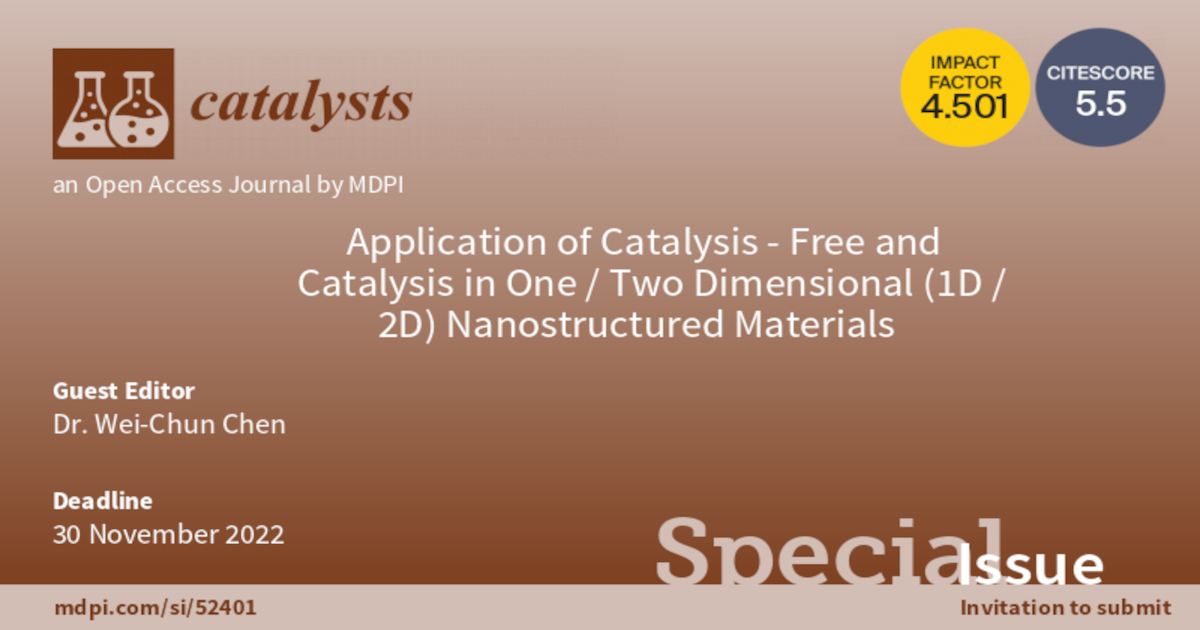- 4.0Impact Factor
- 7.6CiteScore
- 17 daysTime to First Decision
Application of Catalysis-Free and Catalysis in One/Two Dimensional (1D/2D) Nanostructured Materials
This special issue belongs to the section “Catalytic Materials“.
Special Issue Information
Dear Colleagues,
This Special Issue of catalysis is focused on recent developments in the area of catalyst-free growth and characterization processing methods, materials, and related implementation. The Special Issue will cover the fundamentals of nanostructured materials and fabricated by various methods, such as vapor–liquid–solid, physical vapor deposition, chemical vapor deposition and atomic layer deposition, etc. Catalyst-free growth of materials has been widely applied in photoelectric fields because of their optical/electronic devices, which have been the subject of plenty of spectacular research. However, the growth of high-quality materials is very difficult due to issues pertaining to physical properties, thermal mismatch, non-stoichiometric stress/strain, etc. This Special Issue aims to cover the most recent progress and advances in the field of the catalyst-free growth and characterization of nanostructured materials, and it is aimed at identifying the current status and future directions in this emerging field via fusions of environmental science, chemistry, and materials science. In addition, due to the recent advancements in advanced process technology, future electronic and optoelectronic devices will not only be based on two-dimensional epi-wafers, but, using lateral patterning, more sophisticated three-dimensional objects (quantum dots, wires) can be grown. This is a big challenge as the growth conditions are very much different in that case, and the characterization of such structures is much more difficult. Also, challenges such as process control, cost, material integrity, and chemical and structural stability with improved functionalities are yet to be completely resolved. Therefore, this Special Issue covers the significance of advanced materials for various catalyst-free growth technologies and materials properties.
Dr. Wei-Chun Chen
Guest Editor
Manuscript Submission Information
Manuscripts should be submitted online at www.mdpi.com by registering and logging in to this website. Once you are registered, click here to go to the submission form. Manuscripts can be submitted until the deadline. All submissions that pass pre-check are peer-reviewed. Accepted papers will be published continuously in the journal (as soon as accepted) and will be listed together on the special issue website. Research articles, review articles as well as short communications are invited. For planned papers, a title and short abstract (about 250 words) can be sent to the Editorial Office for assessment.
Submitted manuscripts should not have been published previously, nor be under consideration for publication elsewhere (except conference proceedings papers). All manuscripts are thoroughly refereed through a single-blind peer-review process. A guide for authors and other relevant information for submission of manuscripts is available on the Instructions for Authors page. Catalysts is an international peer-reviewed open access monthly journal published by MDPI.
Please visit the Instructions for Authors page before submitting a manuscript. The Article Processing Charge (APC) for publication in this open access journal is 2200 CHF (Swiss Francs). Submitted papers should be well formatted and use good English. Authors may use MDPI's English editing service prior to publication or during author revisions.
Keywords
- 2D materials
- TMDs
- oxide
- nitride
- nanowires
- nanorods

Benefits of Publishing in a Special Issue
- Ease of navigation: Grouping papers by topic helps scholars navigate broad scope journals more efficiently.
- Greater discoverability: Special Issues support the reach and impact of scientific research. Articles in Special Issues are more discoverable and cited more frequently.
- Expansion of research network: Special Issues facilitate connections among authors, fostering scientific collaborations.
- External promotion: Articles in Special Issues are often promoted through the journal's social media, increasing their visibility.
- e-Book format: Special Issues with more than 10 articles can be published as dedicated e-books, ensuring wide and rapid dissemination.

